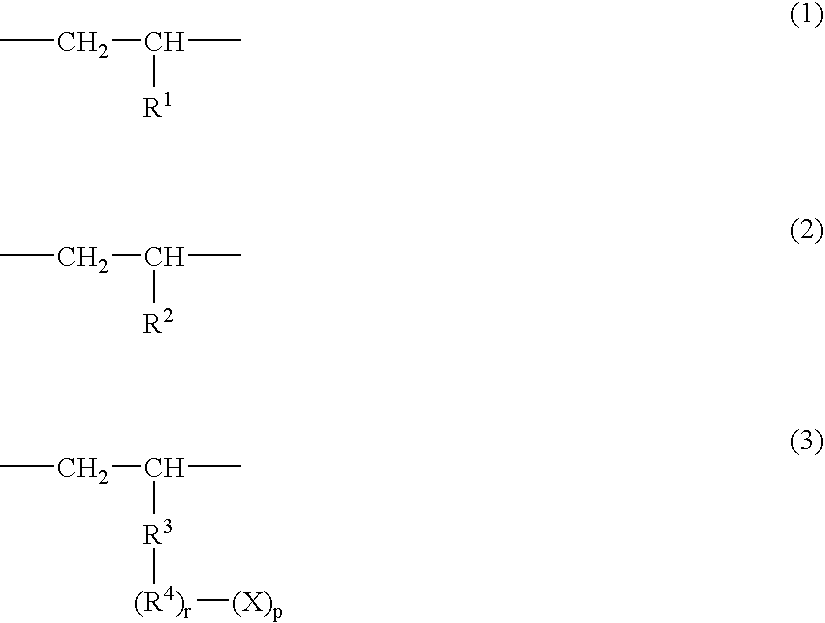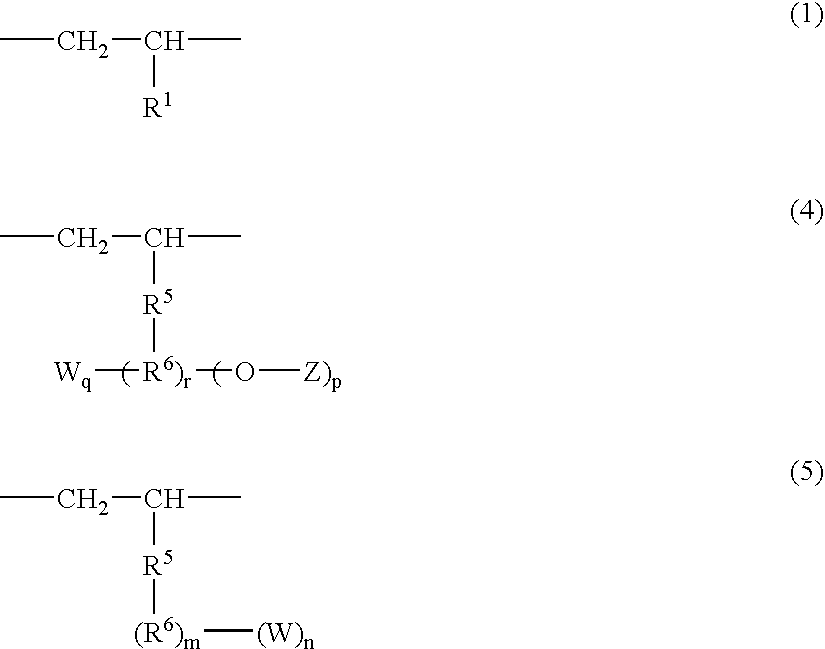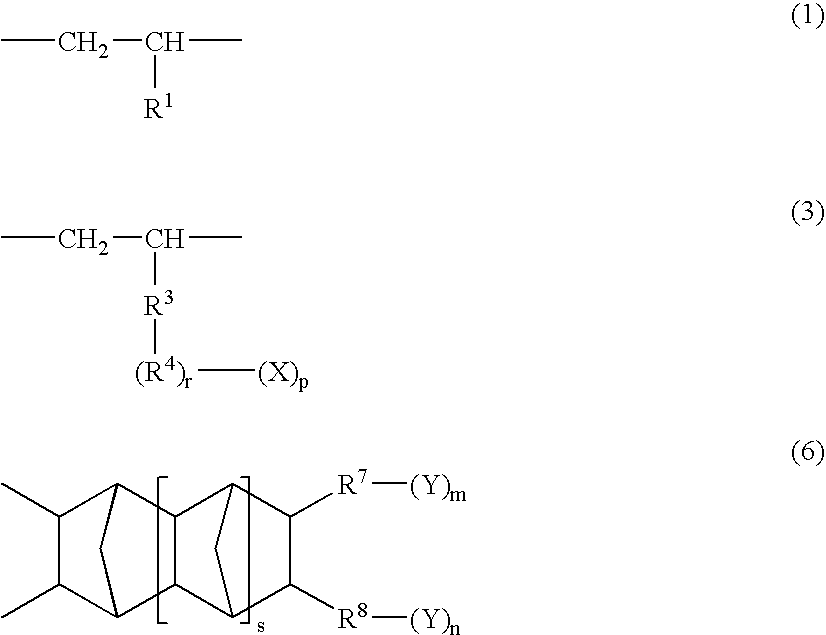Polar group-containing olefin copolymer, process for preparing the same, thermoplastic resin composition containing the copolymer, and uses thereof
a technology of polar group and olefin, which is applied in the direction of adhesives, etc., can solve the problems of low compatibility with polar resins such as nylon and evoh, low adhesion properties to polar resins and metals, and difficulty in using polyolefins, etc., and achieve excellent adhesion properties to metals or polar resins. , the effect of excellent compatibility
- Summary
- Abstract
- Description
- Claims
- Application Information
AI Technical Summary
Benefits of technology
Problems solved by technology
Method used
Image
Examples
example 1
[1520]In a 1000 ml glass polymerization reactor thoroughly purged with nitrogen, 400 ml of n-decane was placed, then nitrogen was passed through at a rate of 20 l / hr, and the contents were maintained at 130° C. for 10 minutes. Then, 0.6 mmol of triisobutylaluminum was added, followed by further adding 0.48 mmol of undecen-1-ol (having been dried over activated alumina) represented by the following formula.
[1521]
[1522]Then, 1.100 mmol of methylaluminoxane was further added, and passing of nitrogen was stopped, followed by passing ethylene at a rate of 12.5 l / hr. Finally, a toluene slurry solution in which 0.002 mmol of dimethylsilylene(2,7-dimethyl-4,5-(2-methyl-benzo)-1-indenyl)(2,7-di-tert-butylfluorenyl)zirconium dichloride and 0.500 mmol of methylaluminoxane had been contacted at room temperature for 10 minutes was added to initiate polymerization. After the polymerization was conducted at 130° C. for 1 hour at atmospheric pressure, a small amount of isobutyl alcohol was added to...
example 2
[1525]In a 1000 ml glass polymerization reactor thoroughly purged with nitrogen, 400 ml of toluene was placed, then nitrogen was passed through at a rate of 20 l / hr, and the contents were maintained at 90° C. for 10 minutes. Then, 0.6 mmol of triisobutylaluminum was added, followed by further adding 0.48 mmol of 1,2-epoxy-9-decene (having been dried over silica alumina) represented by the following formula.
[1526]
[1527]Then, 1.100 mmol of methylaluminoxane was further added, and passing of nitrogen was stopped, followed by passing ethylene at a rate of 12.5 l / hr. Finally, a toluene slurry solution in which 0.002 mmol of dimethylsilylene(2,7-dimethyl-4,5-(2-methyl-benzo)-1-indenyl)(2,7-di-tert-butylfluorenyl)zirconium dichloride and 0.500 mmol of methylaluminoxane had been contacted at room temperature for 10 minutes was added to initiate polymerization. After the polymerization was conducted at 90° C. for 1 hour at atmospheric pressure, a small amount of isobutyl alcohol was added to...
example 3
[1530]In a 1000 ml glass polymerization reactor thoroughly purged with nitrogen, 400 ml of n-decane was placed, then nitrogen was passed through at a rate of 20 l / hr, and the contents were maintained at 90° C. for 10 minutes. Then, 0.6 mmol of triisobutylaluminum was added, followed by further adding 0.48 mmol of (2,7-octadien-1-yl)succinic anhydride (having been dried over activated alumina) represented by the following formula.
[1531]
[1532]Then, 1.100 mmol of methylaluminoxane was further added, and passing of nitrogen was stopped, followed by passing ethylene at a rate of 12.5 l / hr. Finally, a toluene slurry solution in which 0.002 mmol of dimethylsilylene(2,7-dimethyl-4,5-(2-methyl-benzo)-1-indenyl)(2,7-di-tert-butylfluorenyl)zirconium dichloride and 0.500 mmol of methylaluminoxane had been contacted at room temperature for 10 minutes was added to initiate polymerization. After the polymerization was conducted at 130° C. for 1 hour at atmospheric pressure, a small amount of isobu...
PUM
| Property | Measurement | Unit |
|---|---|---|
| temperature | aaaaa | aaaaa |
| temperature | aaaaa | aaaaa |
| temperature | aaaaa | aaaaa |
Abstract
Description
Claims
Application Information
 Login to View More
Login to View More - R&D
- Intellectual Property
- Life Sciences
- Materials
- Tech Scout
- Unparalleled Data Quality
- Higher Quality Content
- 60% Fewer Hallucinations
Browse by: Latest US Patents, China's latest patents, Technical Efficacy Thesaurus, Application Domain, Technology Topic, Popular Technical Reports.
© 2025 PatSnap. All rights reserved.Legal|Privacy policy|Modern Slavery Act Transparency Statement|Sitemap|About US| Contact US: help@patsnap.com



